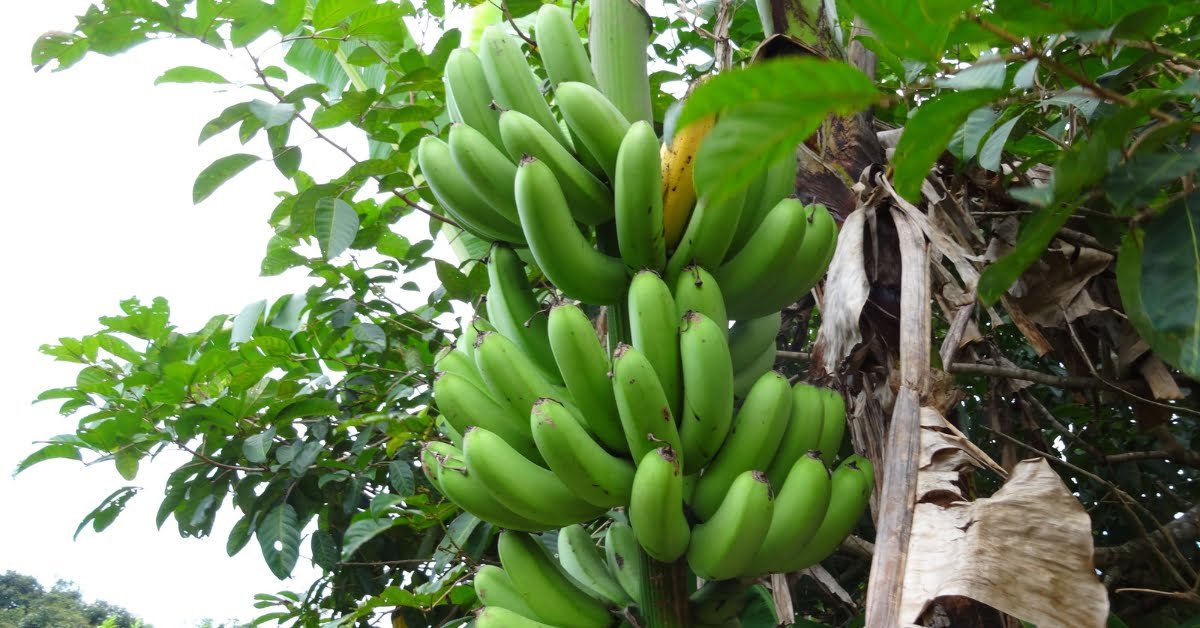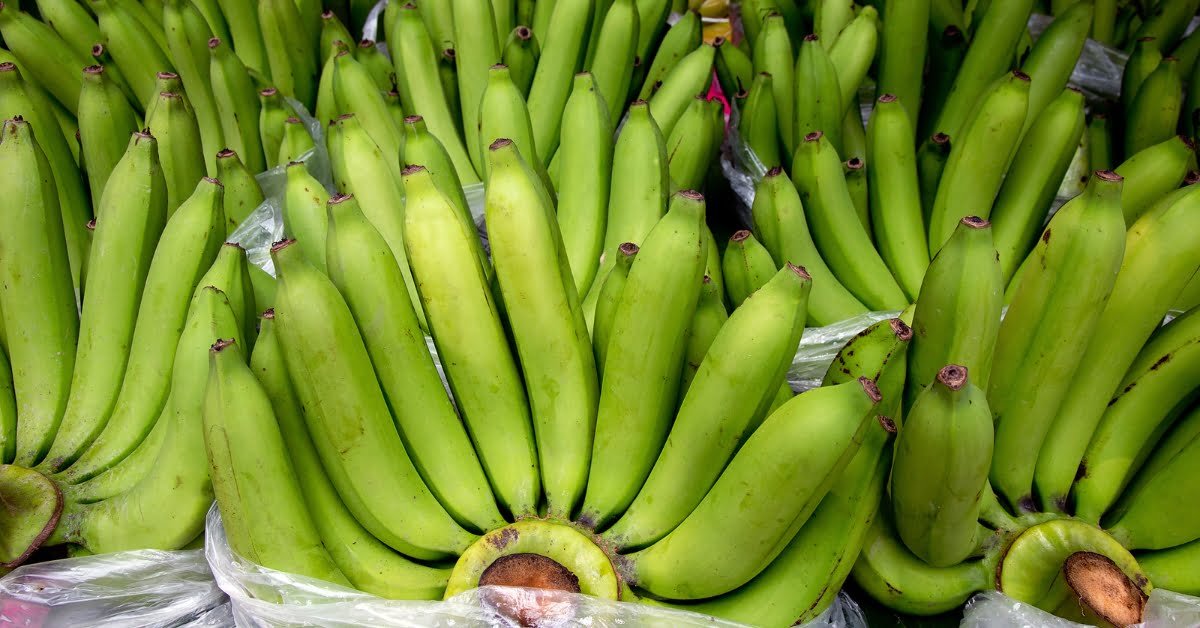Dwarf cavendish banana trees can grow indoors and outdoors and produce large bunches of bananas every harvesting season. Read our guide to learn how to grow a healthy Dwarf Cavendish banana tree.
Cavendish Banana
| Common Names or AKA Names: |
|
| Botanical Name: | Musa acuminata |
| Family: | Musaceae |
| Plant Type (Zone 8b): | Intermittent |
| Hardiness Zones: | Zones 8 through 10 |
| Mature Size: | 8′ – 10′ feet tall |
| Native Area: | Andaman Islands, Bangladesh, Borneo, China South-Central, China Southeast, India, Java, Laos, Lesser Sunda Islands, Malaysia, Myanmar, Nicobar Islands, Philippines, Sri Lanka, Sulawesi, Sumatra, Thailand, Vietnam |
| Bloom/Harvest Time: | 9-12 months |
| Sun/Light Exposure: | 6 to 12 hours of Light. |
| Planting Depth: | 1′ Foot Deep. |
| Soil Preferences: | Dry, Well-Drained & Nutrient-Rich Soil |
| Soil pH: | 5.5 – 6.5 |
| Aquaponically-Friendly: | YES | LEARN MORE |
| Hydroponically-Friendly: | YES | LEARN MORE |
DESCRIPTION:
The banana plant is an impressive and fast–growing intermittent herb that can reach heights of up to 15′ feet. Its trunk, or pseudostem, consists of overlapping layers of leaf sheaths which guard the growing shoot within. At the top are multiple long leaves emanating from a single crown that form an umbrella shape when fully mature. Underneath these leaves emerge inflorescences which then produce bunches of yellow fruits known as bananas – actually clusters of individual fruit fingers coated in thin skin for transportability and storage purposes while also providing sweetness when ripe. Some varieties may even produce seed pods at their base containing small black seeds used for propagation if desired.
USE:
Cavendish bananas are a popular variety due to their high quality and taste. They account for 47% of global banana production between 1998 and 2000, and are the bulk of bananas entering international trade. These fruits can be eaten raw, used in baking or fruit salads, or as accompaniments to other dishes. In food markets they appear partially green when unripe but will turn yellow as they ripen naturally – during this process the starch is converted into sugar making them sweet. Overripening leads to black skin with mushy flesh inside – which is good for banana bread but not for immediate consumption.
Culture & Cultivation:
The Cavendish banana is one of the most important and widely grown varieties of bananas in the world. It’s a hybrid variety that was discovered by Englishman Sir Walter Cavendish in 1836 and was first cultivated on his estate in England. Since then, it has become one of the most popular types of bananas due to its sweet taste, easy availability, and long shelf life. As such, Cavendish bananas are now grown throughout tropical regions around the globe where they account for nearly all commercial banana production.
Cavendish banana cultivation is primarily focused on creating large monocultures – often called “banana plantations“ – which enable high–yield harvests with minimal effort or cost. Banana plants are typically planted closely together as part of this process to maximize their growth potential while also reducing competition from weeds and other plant species that may reduce yields over time. To further increase yields, farmers may employ various agricultural techniques such as fertilization or irrigation systems depending upon local growing conditions.
In addition to traditional farming practices, some growers have adopted alternative methods for cultivating Cavendish bananas such as organic agriculture or permaculture approaches which focus on using natural elements like pest control instead of chemical interventions when possible. These sustainable approaches not only allow growers to produce higher quality fruits but can also help preserve soil health over time since fewer synthetic inputs are used during production cycles compared with conventional farming models. Additionally, these methods often result in greater drought tolerance among crops since there is less reliance on external water sources for sustenance during times when rainfall levels drop off significantly.
Overall, growing Cavendish bananas is a complex process that requires dedicated effort and expertise to ensure successful harvests. By combining traditional farming practices with modern sustainable methods, however, growers can produce large quantities of high–quality fruits while preserving the environment for future generations.
If you want to learn more about cultivating this specific plant, you might want to check out our online courses where we have plant specific mini courses in addition to our standard fully packed courses and master gardening courses.
Planting & Care:
Before planting your Dwarf Cavendish banana tree, dig a one–foot hole and fill it with a few inches of organic matter like compost or rotted manure, as well as a half pound of fertilizer. Place the rhizome in the soil, making sure that it is deep enough to be buried but also leaving the sucker sticking out at the top. Water the area and lay down six inches of mulch to keep weeds away and lock moisture into the soil.
Soon after planting, you will see a pseudostem growing from the rhizome; this looks like a stem but is just composed of folded banana leaves. The true stem will then emerge from this pseudostem followed by leaves, blossoms and finally bananas! It typically takes nine to fifteen months for an initial flowering before another two to six months pass before they are ready for picking!
Growing new plants can be difficult at times but not to worry Green Grass Grove Academy is here to help! We are excited to offer Online Courses on plant care and other Gardening and Homesteading Courses. Our goal is to provide you with the knowledge and skills necessary to become a successful gardener. Our Online Courses are designed to be self-paced and to be completed at your convenience. Courses contain invaluable information to help you become the ultimate Gardener! In addition, Our Courses have entertaining multimedia, quizzes, and a final exam to test your knowledge. Upon completion of each course, you are eligible to receive a certificate of completion. Some of our most popular courses include Aquaponics/Hydroponics, Plant Pathology, Seeds & Seedlings, Microgreens, Plant Mini-Courses, and Insect Pest & Nutrients Management.
So what are you waiting for? Come on over to Green Grass Grove Academy and let us help you become the ULTIMATE GROWER!
Watering:
To keep your banana tree healthy, it‘s important to water often. Frequency of watering will depend on whether the tree is planted in a pot or in the ground. If potted, check for drainage holes at the bottom and provide enough water to keep the soil damp every two to three days. For trees planted in–ground, ensure that you don‘t over-water as this can lead to mud or sogginess.
Harvesting:
Typically, it can take anywhere from 9–12 months for a banana plant to flower and produce its fruits. During this time, the flowers will emerge beneath the leaves as clusters of yellow fruit fingers that eventually ripen into full–sized bananas. Once ready for harvest, growers should carefully cut each bunch from its stem before transporting them to their destination.
Bananas should be harvested when the fruit is fully ripe, which typically corresponds to a yellow–brown color on the skin. When harvesting Cavendish bananas, it is important to use sharp tools like pruning shears or knives in order to avoid damaging the pseudostem and other surrounding tissue. To begin, cut around each bunch of fruits at its base before gently lifting them free from their stem. Once removed, carefully place each bunch into a container for transport or storage purposes until ready for consumption.
Aphids | Beetles | Nematodes | Spider Mites
Take Our Online Insect Pest Management Course to become an expert at dealing with these pests and others too!
Learn More About This Plant!
Lorem ipsum dolor sit amet, consectetur adipiscing elit. Ut elit tellus, luctus nec ullamcorper mattis, pulvinar dapibus leo. Lorem ipsum dolor sit amet, consectetur adipiscing elit. Ut elit tellus, luctus nec ullamcorper mattis, pulvinar dapibus leo.
This supermarket variety of banana, the Cavendish banana, descended from a banana plant first grown in a hothouse in northern England in the 1800s.
Prune back any leaves that prevent developing fruit from receiving fun sun. Remove any dead leaves. After a stalk has produced fruit, prune it back to the ground. This stalk can be sliced and used as mulch.
Banana fruits are classified as berries; true berries are fleshy fruits that come from a single flower with one ovary and typically have several seeds.
The fruits of wild bananas are full of black seeds, making them unpleasant to eat. Domestication and selection of bananas over the years has created edible varieties with tasty, fleshy fruits that are absent of seeds.
The information in this post is NOT medical/nutrition advice, as we are not doctors or nutritionists. This information is for informational/entertainment purposes only and is not a substitute for professional medical advice, nutrition advice, diagnosis or treatment. If you have any concerns or questions about your health or nutrition intake, you should always consult with a doctor or other licensed and qualified healthcare professional.
Green Grass Grove Plant Profiles
No posts found!






